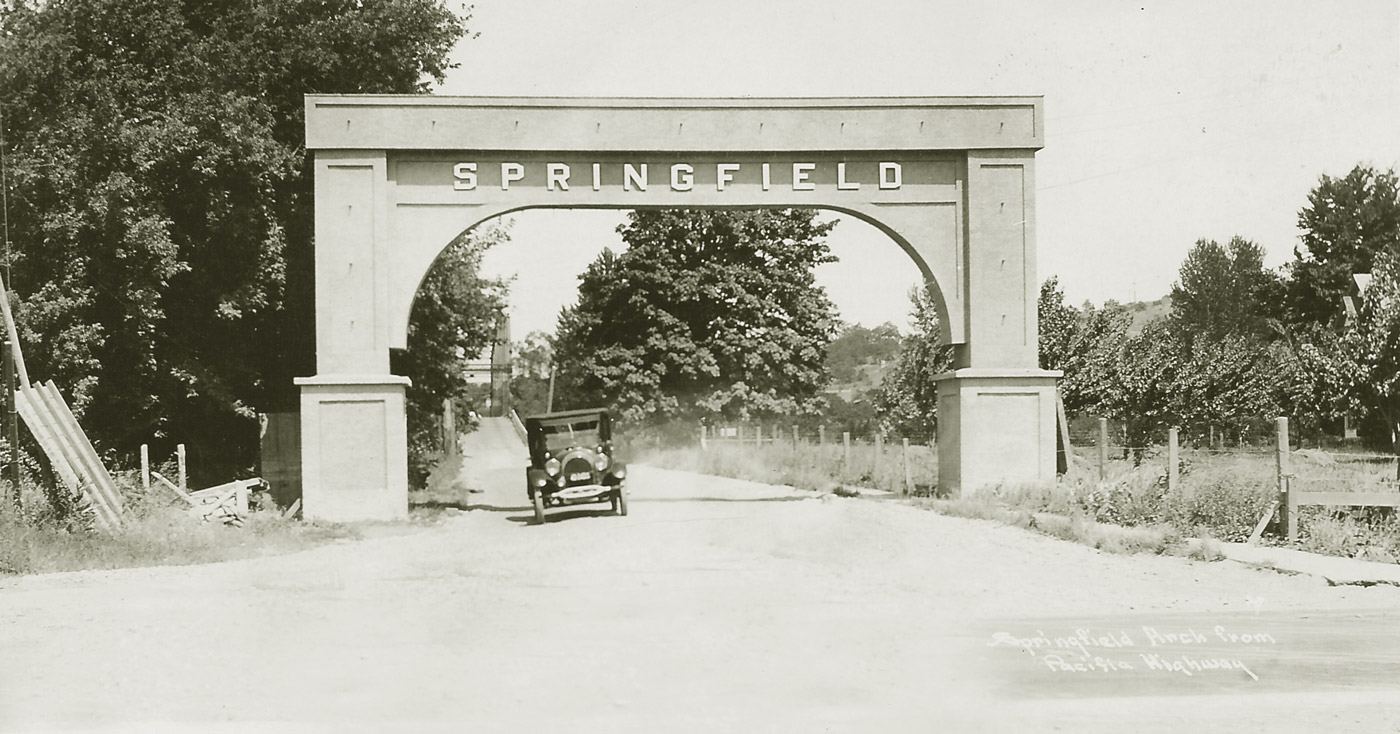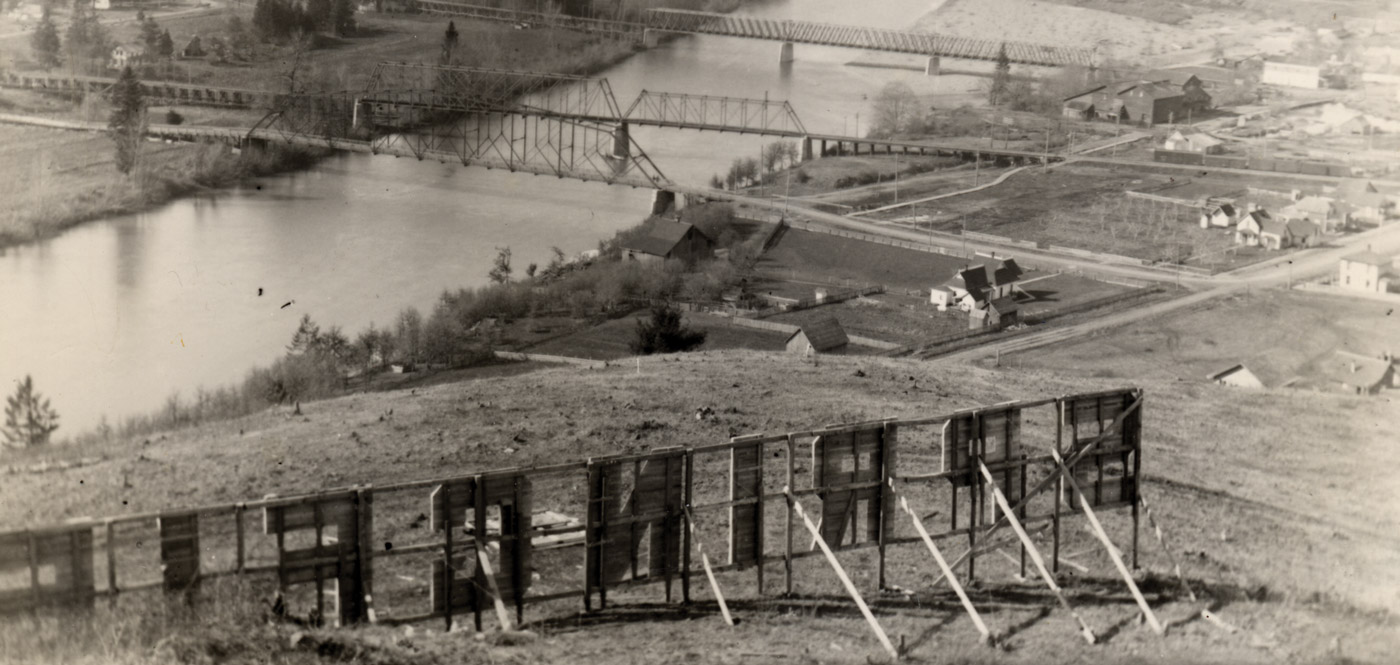Springfield. Eugene’s neighbor to the west. Eugene’s founder Eugene Skinner built his cabin on the west bank of the Willamette River, near what is now Skinner Butte, in 1846. Springfield founder Elias Briggs built his cabin on the east bank of the Willamette River in 1849. But before that, there were the
Kalapuyans (or Calapooian). According to archeological evidence, the Kalapuyans and their ancestors may have been in what is now the Eugene area for as long as 10,000 years. Springfield has Dorris Ranch, settled in 1892, site of the first filbert ranch in the country. In 1871, the Oregon and California Railroad was supposed to be built through Springfield, until a Eugene businessman paid to have the tracks rerouted through Eugene. Briggs built a ferry over the Willamette River, then replaced it with wooden bridges that were twice swept away. These regular floods have a great impact on the region’s development, and in particular, Glenwood.

Madeline McGraw, curator of the Springfield Museum says the geographic and political forces brought to bear on Springfield are a “wild, weird web of stuff.” “The easiest way to talk about the history is just to amble through from the beginning,” she says. Prior to the 1840s, there were about 10,000 people living within the Kalapuyan homelands. They were farmers and harvested vast numbers of camas bulbs as a staple food source. This area is historically oak savannah, but the seasonal burns that the tribes did to harvest the camas changed the landscape. By the time a malaria epidemic took hold in the 1830s, there were less than 350 Kalapuyans here. Then the Briggs family arrived, and their donation land claim included a spring in a field — hence the name. (The spring was on 2nd Street, where the Spring Site Apartments are currently.)
McGraw tells a story about how it almost could have been named Scanty Grease. “Some folks were riding through and asked Elias’s wife, Mary, if they could borrow some grease. She said, ‘Oh, we don’t have any grease here, you know, we’re scanty on grease.’ It took a little while before Springfield became the official name!”
The Briggs dug the Mill Race, using it to power their flour mill and a saw mill. City improvements happened fast after that. In the last 50 years of the 19th century Springfield got its first school teacher — Agnes Stewart — in 1854. The first hotel opened in 1890. By 1900, there were about 300 people living here, maybe slightly more, McGraw says. The town needed a hospital, which opened in 1900. “So that means for 50 years there were people living here with the closest doctors in Eugene,” she says.
This is also around the time that Glenwood became an idea. The land claims of two families, the Judkins and the Sweets, encompassed the Glenwood area. “The Glenwood area has always been looked down upon, and so we can see that really clearly in the 1920s and ’30s,” McGraw says, “but there’s evidence going back to the 1850s.” Then, the few Kalapuyans who still lived here were forcibly removed to Grand Ronde and Warm Springs reservations. “But almost immediately, people from those reservations started coming back to work seasonally here for money and to be back on the land that belongs to them,” McGraw says. “The Glenwood and Ferry Street area was likely where those folks would stay. That was also where early black pioneers would stay.”
The laborers and disenfranchised folks were subjected to the regular flooding that scoured the area. Each year, McGraw says buildings would fill with mud, or be completely ripped from their foundations. It was always in a state of being rebuilt, but was more accessible to low-income residents.
While the land in Glenwood, and in parts of Springfield, was desirable, it wasn’t worth much because it was so regularly destroyed by floods. McGraw says this created a unique, hardy community of those who worked hard and refused to give up — qualities we admire today.

The Booth-Kelly lumber mill was brand new in 1902, and that boosted the town tremendously. In the mid-1950s, Springfield was known as “Lunch Bucket City” thanks to all the workers there. Franklin Boulevard, then called the Pacific Highway, was the main highway running from Seattle to San Diego, so travelers had to go through Glenwood. The current riverside trailer parks in Glenwood were originally AutoCamps, sort of like KOAs. Glenwood was a hopping area then, with stores, restaurants, music venues (where black musicians could play) and camping equipment for people driving their Model Ts across the country.
Steven Roth and his brother Paul, owners of Roaring Rapids Pizza, have been involved with Glenwood since about 1995 and they established Roaring Rapids in 2000. They designed and built the mini golf courses that are now Camp Putt, and then took over the original Pietro’s Pizza location.
Steven was originally the Economic Development Coordinator for the city when he first came back to town in 1983. “Springfield has always had a reputation for being business friendly,” Steven says.
He says that when he drives down Franklin Boulevard, much of it looks the same to him except the driving roundabouts and the LTD EmX stations, which was completed in May 2018. “Along Franklin pretty much looks the same as it always has,” he says.
That phase 1 of the Franklin Boulevard work represents years-long design and funding efforts that cost the city nearly $14 million. The city of Springfield along with the city of Eugene and Lane Transit District applied for and received a RAISE grant on November 16, 2021, for $19 million from the U.S. Department of Transportation for the Franklin Boulevard Partnership Project, explains Niel Laudati, Springfield’s assistant city manager. “Within this award Springfield will receive $7.6 million and will focus on building a roundabout at Mississippi Avenue and Franklin Boulevard.Additional funding will be pursued in the future to continue to make efforts to build the entire planned corridor.”
One question Steven says he hears more often than anything else is why is Roaring Rapids the only
business or restaurant along this gorgeous riverfront. The Roths are supportive of development along the riverfront, with an emphasis on a variety of housing solutions and infrastructure development, like storm drains and sewers. Improvements to things like sewers are often under-the-radar projects, but
development can’t happen without them. The first construction phase of a new trunk wastewater line within the South Franklin Boulevard and McVay Highway 225 was completed in 2014, and the second phase was completed in 2015. “The project allows for environmentally responsible development and redevelopment in this area and facilitates the ability for land owners in this area to annex their properties into the city of Springfield,” explains Laudati.

In 2018, the Springfield Economic Development Agency authorized the city manager to purchase a 7-acre riverfront parcel in Glenwood. This “River District’s” future development effort will do more than just about anything else to change the face of Glenwood for decades to come. The purchase of this plot dates back to a voter-approved urban renewal district formed in 2004. Laudati says there is a lot of activity in Glenwood that is easy to overlook. “Glenwood has three nice hotels, which is unusual for an area of that size,” Laudati says. Weyerhaeuser recently completed their regional headquarters on the east southeast side of Glenwood. And the development of the Glenwood riverfront is moving forward.”
The city has the property it needs for the planned development along with partnerships with the adjacent property owners. The city is working with a developer and the adjacent property owners to develop the Glenwood acreage. “Springfield is in the best spot that it’s been in years, and I think Glenwood is too,” Laudati says. “It takes years to pull together different owners and commercial groups and we’ve done that. So there’s actually a lot going on!”


